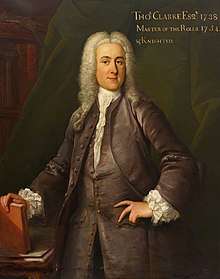Thomas Clarke (judge)
Sir Thomas Clarke PC FRS (1703 – 13 November 1764) was a British judge who served as Master of the Rolls. He was the son of a carpenter and a pawnbroker from St Giles in the Fields, and was educated at Westminster School between 1715 and 1721 thanks to the help of Zachary Pearce. On 10 June 1721 he matriculated to Trinity College, Cambridge, graduating with a BA in 1724.[1][2] He became a fellow of Trinity College in 1727, and a member of Gray's Inn the same year. Clarke was evidently knowledgeable in Roman law, and was mentioned in a poem called the causidicade as a possible Solicitor General in 1742.[3] He became a King's Counsel (KC) in 1740, and in 1742 left Gray's Inn to join Lincoln's Inn, which he became a bencher of in 1754.[2]
Sir Thomas Clarke | |
|---|---|
 | |
| Master of the Rolls | |
| In office 25 May 1754 – 13 November 1764 | |
| Preceded by | Sir John Strange |
| Succeeded by | Sir Thomas Sewell |
| Personal details | |
| Born | 1703 |
| Died | 13 November 1764 (aged 60–61) |
| Nationality | British |
| Alma mater | Trinity College, Cambridge |
| Profession | Barrister, judge |
In 1747 he was elected a Member of Parliament for St Michael's, and in 1754 was returned for Lostwithiel. After the death of the Master of the Rolls, Sir John Strange, Clarke was offered the position. The job was originally offered to William Murray, later Lord Mansfield, but he turned it down.[2] If he had accepted, Clarke might instead have succeeded Murray as Attorney General for England and Wales.[2] Clarke was officially appointed on 25 May 1754, and was knighted at the same time. In June 1754 he was invested as a Privy Councillor (PC). Clarke evidently discharged his duties "with great credit" for ten years,[3] until his death in office on 13 November 1764. He was buried in the Rolls Chapel, now the main library of King's College London.[3]
Clarke was a close friend of the Earl of Macclesfield, and this friendship combined with his unclear parentage started rumours that Clark was in fact Macclesfield's son.[2] In his will, Clarke left his Flitcroft-designed home,[4] Branch Hill Lodge, to Macclesfield.[5] Outside politics and law, Clarke was a Fellow of the Royal Society (FRS), and "devoted himself to philosophical pursuits".[3]
References
- "Clark, Thomas (CLRK721T)". A Cambridge Alumni Database. University of Cambridge.
- "Oxford DNB article: Clarke, Sir Thomas (subscription needed)". Oxford University press. 2004. Retrieved 6 June 2009.
- Foss (1870) p.167
- Colvin (2008) p.382.
- T F T Baker; Diane K Bolton; Patricia E C Croot (1989). C R Erlington (ed.). Hampstead: Frognal and the Central Demesne. 9. Hampstead, Paddington, Central London: British History Online. pp. 33–42.
Bibliography
| Wikisource has the text of the 1885–1900 Dictionary of National Biography's article about Clarke, Thomas. |
- Foss, Edward (1870). A Biographical Dictionary of the Justices of England (1066–1870). Spottiswoode and Company.
- Colvin, Howard (2008). A biographical dictionary of British architects, 1600–1840 (4th ed.). Yale University Press. ISBN 0-300-12508-9.
| Parliament of Great Britain | ||
|---|---|---|
| Preceded by Edward Pickering Richard Lloyd |
Member of Parliament for Mitchell 1747–1754 With: Albert Nesbitt 1747–53 Arnold Nesbitt 1753–54 |
Succeeded by John Stephenson Robert Clive |
| Preceded by Richard Edgcumbe |
Member of Parliament for Lostwithiel 1754–61 With: James Edward Colleton |
Succeeded by James Edward Colleton George Howard |
| Legal offices | ||
| Preceded by Sir John Strange |
Master of the Rolls 25 May 1754 – 13 November 1764 |
Succeeded by Sir Thomas Sewell |
.svg.png)